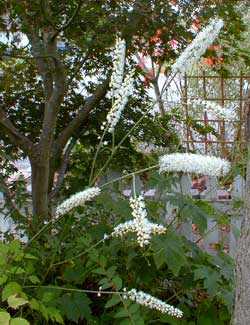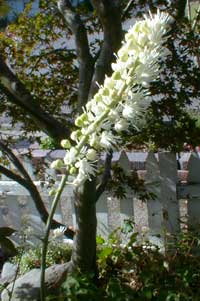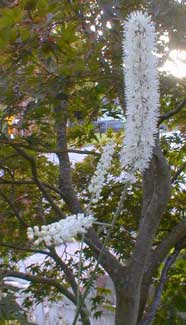
Kamchatra Bugbane; aka:
'White Pearl' Autumn Snakeroot
"Wha'd Ah take? Well, le' me see:
Firs', — horhound drops an' catnip tea;
Den rock candy soaked in rum,
An' a good sized chunk o' camphor gum;
Next Ah tried was castor oil,
An' snakeroot tea brought to a boil."
"Calling the Doctor"
by John Wesley Holloway
from The Book of American Negro Poetry,
1922
Kamchatra Bugbane or White Pearl Snakeroot, a Japanese cultivar of a plant native to Russia, has particularly large long bottlebrush flowers that can begin as early as July or August & last through most of Autumn, though in our garden they begin blooming in September & are at their height of gorgeousness in October. In our garden, even while the leaves are starting to die back for winter, the flower stalks continue to produce blossoms right through to November.
 Formerly named Cimicifuga simplex 'White Pearl,' & still very often sold under that name, its correct current name is Actae matsumurae 'White Pearl,' in Europe & Russia sometimes sold as 'Armleuchter.'
Formerly named Cimicifuga simplex 'White Pearl,' & still very often sold under that name, its correct current name is Actae matsumurae 'White Pearl,' in Europe & Russia sometimes sold as 'Armleuchter.'The foliage for 'White Pearl' easily reaches three feet tall, & the white foxtail flowers rise to five & a half feet or taller. After a few years, once the roots are well established, it will become lush & bushy. As a new plant, it'll seem tall & thin for quite a while, because it can take three or four years to be fully mature & become ready to bloom, & a couple more after that to bulk up to a clump that produces more than two or three blooms at a time. A mature specimen in the right location, though, is just one of the most splendid things to see blooming so late in the year.
 It is shown in the first photo above in October (2004), with the trunk of a shading Japanese Maple in the background. The second photo] (October 2003) is a close-up of one of the flowers with its many tiny buds only partially open. The third close-up (October 2004) shows the maximum fluffiness of full bloom.
It is shown in the first photo above in October (2004), with the trunk of a shading Japanese Maple in the background. The second photo] (October 2003) is a close-up of one of the flowers with its many tiny buds only partially open. The third close-up (October 2004) shows the maximum fluffiness of full bloom.If grown in shade or partial shade such as it likes best, it almost never needs staking. It can be weaker in too much sunlight, & prone to scorching if sun is too strong or soil is permitted to dry out completely. It wants humousy consistently moist soil, & is extremely hardy when its few needs are met. Though slow to spread, it does do so by its thick rhizomes (which lend it the name Snakeroot). It will over time colonize a little area most prettily.
The leaves exude an insecticide, so that the plant is not often attacked by garden pests. The discarded genus name Cimicifuga means "to drive away." In the 1700s its leaves were harvested, dried, & powdered, to add to mattress stuffing in order to repel bedbugs, hence the name Bugbane or occasionally Bugwort. As for the garden's slugs & snails, these alas are not repelled. Once mature, it will be growing so fast that a few snail-nibblings won't be too noticeable, but the plant can be at risk during spring's tender grow-back, when the first new shoots are small & few.
The herbal remedy quacks have long tagged bugbane as useful for women experiencing hot flashes at menopause or after treatment for breast cancer or for menstrual pain. Herb lore was so insistant as to its numerous values that double-blind clinical trials were finally undertaken (conducted by, among others, Jacobson et al, reported in the Journal of Clinical Oncology, May 2001). Alas bugbane was found to be no more effective than placebo.
Despite that efficacy was the same among women who received a placebo as received bugbane, the herbal quacks have somehow seen only the word "efficacy," & continue to recommend bugbane for bogus medicinal benefits. The phytoestrogens of bugbane might interfer with fertility, but are not well enough processed by the human body to actually have the alleged value for human estrogen replacement. It is nevertheless a multi-million dollar business just selling bugbane for this bogus purpuse, & because placebo effect is real enough insofar as that goes, "believers" can become very fanatic on the basis of their personal experience, the science of doubleblind studies be damned.
The real value of Bugbane regards its considerable merit as an ornamental shade perennial providing blooms even for late Autumn gardens before dying back in winter. Its greatest enemy is dryness so it should be positioned well within reach of a sprinkler or soaker.